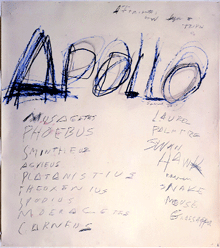Whitney hosts a retrospective of Cy Twombly’s half-century of works on paper
A major retrospective of 50 years of works on paper by Cy Twombly is on view at the Whitney Museum. This celebration of Twombly’s 75th birthday has been presented at a number of important venues throughout the world, including Russia’s State Hermitage Museum in St. Petersburg.
Painting and drawing through the past half-century, Twombly has never been corralled into any one movement. Neither Abstract Expressionist, minimalist nor conceptualist, his idiosyncratic work seems to be all at once.
The childlike scribbling, handwriting and graffiti have all been used to describe Twombly’s art, though none actually convey anything of the mastery of his work, the absolute grace of his oeuvre.
Using a variety of materials and methods—including paint, crayon and collage—Twombly has taken inspiration from a vast array of sources. Greek and Roman mythology, epic poetry, the great battles of classical history and nature have been re- visited over and over, making for a surprisingly cohesive body of work.
The works at the Whitney, installed chronologically, can almost be read narratively. The vast expanses of white and off-white background in the pieces emphasize Twombly’s respect for the ground of the work. He consistently insists that he has a greater sense of paper than of paint, and the backgrounds seem to be as important—if not more so—than the marks, words and images. This is readily apparent in his famous “chalkboard” series where the incised white crayon mark cannot be separated from the wet, gray paint of the background.
Under Twombly’s masterful hands, the grounds, marks, scribbling, color and handwritten cultural allusions all make for an impossible elegance; what Roland Barthes has called “ a sort of superior aestheticism.”
gaycitynews.com


































